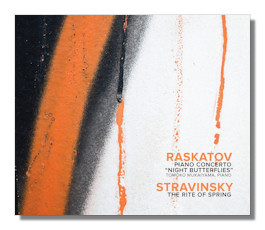
The Internet's Premier Classical Music Source
Related Links
-
Raskatov Reviews
Stravinsky Reviews - Latest Reviews
- More Reviews
-
By Composer
-
Collections
DVD & Blu-ray
Books
Concert Reviews
Articles/Interviews
Software
Audio
Search Amazon
Recommended Links
Site News
 CD Review
CD Review
Night Butterflies

- Alexander Raskatov: Piano Concerto "Night Butterflies"
- Igor Stravinsky: The Rite of Spring
Tomoko Mukaiyama, piano & vocalizations
Seattle Symphony/Ludovic Morlot
Seattle Symphony Media SSM005 63:19
Tomoko Mukaiyama and the Seattle Symphony under Ludovic Morlot give us the recorded debut of Alexander Raskatov's "Night Butterflies" Piano Concerto. The work is nothing short of wild. The orchestral parts call for eerie, nocturnal sounds that are echoed in the piano. While we usually think of butterflies as happy, delicate creatures, composer Alexander Raskatov clearly believes in bringing forth the darkness of the night. It's no wonder that he's been called "one of the most interesting composers of his generation", because the work is as difficult to explain as it is exceptionally assured harmonically and structurally. Tomoko Mukaiyama has a lot to do in illustrating all the creatures and spooky sounds of the evening. In 12 movements, the composer believes that he illustrates the sadness and anxiety of losing his homeland as an adult, and I'm willing to believe he's succeeded. There's a kind of nervous tension here that never especially resolves. So we have a work inspired by the most delicate of creatures, and inspired by the most difficult of feelings.
The Seattle Symphony plays with confidence and tremendous conviction, allowing every dark corner of the score to be illuminated. Ludovic Morlot conducts the work as if he believes it to be a masterpiece, and we are forced to believe it through the careful attention to dynamics, the hairpin changes in mood, and the thoroughly exciting and involving execution. It goes without saying that Mukaiyama is amazing, she plays with total confidence, and she's even called on to "sing" a neutral "ahh" near the works' end. It adds to the atmosphere and she's well-captured. This is a very important addition to th concerto repertoire.
In The Rite of Spring, there is less to explain, but just as much to admire. Morlot takes the introduction at an unusually broad pace, and catches the attention right away. This is the first true blockbuster he's taken on for Seattle Symphony Media, and he really shows off the splendor of his orchestra. The woodwinds are absolutely breathtaking, but the Seattle strings and brass deserve special mention too. Spring Rounds sounds incredible, but I would have liked a little more savagery in the following Ritual of the Rival Tribes. I can't help but admire the carefully balanced orchestral sections, though. The end of Part One is just not quite hot enough, despite admirably clarity à la Boulez.
Part Two begins promisingly; the playing is nothing short of excellent, and full of color. The wind exchanges are amazingly vivid. In the Mystic Circle of the Young Girls, the strings are both flowing and propulsive, giving this particular section more character than usual. The brass are as warm here as you could wish until the buildup into the Glorification of the Chosen One, which begins deceptively slowly before exploding. Here, the Seattle forces show some signs of fatigue (this is at least partially taken from a marathon evening with all three major Stravinsky ballets) but still, it's very satisfying. The Procession of the Ancestors is astonishingly vivid; think Fantasia, folks. The whole performance is capped by a thrilling Sacrificial Dance. Many performances of the Rite suffer from a tepid ending, especially when detail and clarity are part of the mission statement. But that doesn't happen here, and the orchestra gives one last massive burst of energy to make it happen. This is an extremely intelligent and rewarding program.
Copyright © 2014, Brian Wigman



















